|
|

|
|
Author
|
Topic: Orbital Sciences Antares-Cygus COTS demo flight
|
Robert Pearlman
Editor Posts: 42988
From: Houston, TX
Registered: Nov 1999
|
 posted 08-22-2013 07:38 PM
posted 08-22-2013 07:38 PM
   
Orbital Sciences Corporation release COTS Demonstration Mission Schedule Update (as of August 22, 2013)Following a planning and coordination meeting held Wednesday (Aug. 21), Orbital and NASA have identified Sept. 17, 2013 as the targeted launch date for the COTS Demonstration Mission to the International Space Station. The launch of Orbital's Antares rocket with the company's Cygnus cargo logistics spacecraft will originate from the Mid-Atlantic Regional Spaceport launch pad 0A located at NASA's Wallops Flight Facility. Orbital's Antares team is targeting a launch time of 11:16 a.m. EDT (1516 GMT), which is at the opening of an available 15-minute launch window. |
Robert Pearlman
Editor Posts: 42988
From: Houston, TX
Registered: Nov 1999
|
 posted 09-05-2013 12:11 PM
posted 09-05-2013 12:11 PM
   
NASA release Antares-Cygnus approved for Sep. 17 launchOrbital Sciences Corp. managers held a Flight Readiness Review Wednesday and gave a "go" to proceed toward a targeted Sept. 17 launch of the company's demonstration mission to the International Space Station. The company is scheduled to launch its Cygnus cargo resupply spacecraft to the orbiting laboratory on Sept. 17 at 11:16 a.m. EDT (1516 GMT). The Cygnus will launch aboard an Orbital Antares rocket from the Mid-Atlantic Regional Spaceport Pad-0A at the agency's Wallops Flight Facility in Virginia.
The Sept. 17 launch date is contingent upon a Sept. 6 launch from Wallops of NASA's Lunar Atmosphere and Dust Environment Explorer (LADEE) mission. Any adjustment to the LADEE launch date could affect the ultimate target date for the Antares/Cygnus launch.
A Sept. 17 launch of Cygnus would result in a Sept. 22 grapple and berthing of the cargo spacecraft by the space station's Expedition 37 crew, following a series of test maneuvers by the spacecraft upon its approach to the station.
Orbital is building and testing Cygnus and Antares under NASA's Commercial Orbital Transportation Services development initiative. After successful completion of this demonstration mission to the station, Orbital will begin conducting eight planned cargo resupply flights to the space station through NASA's $1.9 billion Commercial Resupply Services contract with the company. |
Robert Pearlman
Editor Posts: 42988
From: Houston, TX
Registered: Nov 1999
|
 posted 09-05-2013 12:12 PM
posted 09-05-2013 12:12 PM
   
collectSPACE Orbital Sciences' first space station supply ship named after astronautWhen a first-of-its-kind commercial cargo spacecraft lifts off to the International Space Station later this month, it will fly under the name of the astronaut who helped make the historic mission possible. Orbital Sciences Corporation revealed Wednesday (Sept. 4) it had christened its first Cygnus resupply ship after G. David Low, a space shuttle astronaut who was overseeing the Dulles, Va. company's development of its commercial resupply launch system when he died of cancer in 2008. "Orbital has a tradition going back 25 years or more of naming many of our launch vehicles and spacecraft, and we're going to continue that tradition on this one," Frank Culbertson, Orbital's executive vice president and a former NASA astronaut, told reporters Wednesday. "We are very proud to name the spacecraft 'G. David Low' and carry this tradition and honor him in this way into space." |
Robert Pearlman
Editor Posts: 42988
From: Houston, TX
Registered: Nov 1999
|
 posted 09-07-2013 01:50 PM
posted 09-07-2013 01:50 PM
   
Orbital Sciences photo release Orbital's Cygnus Cargo Logistics Spacecraft Successfully Mated with Antares RocketOrbital Sciences successfully mated its Cygnus cargo spacecraft to its Antares rocket on Friday (Sept. 6) in preparation for its Sept. 17 launch from the Mid-Atlantic Regional Spaceport (MARS), located at NASA's Wallops Flight Facility in eastern Virginia. 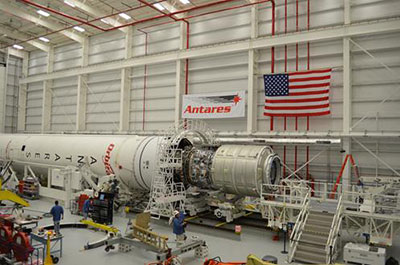 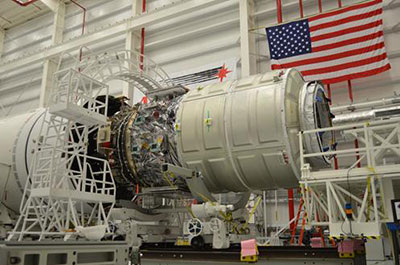
|
Robert Pearlman
Editor Posts: 42988
From: Houston, TX
Registered: Nov 1999
|
 posted 09-13-2013 12:38 AM
posted 09-13-2013 12:38 AM
   
Orbital Sciences photo release Final Cargo Loaded Aboard CygnusThe final cargo bound for the International Space Station was loaded into Orbital Sciences' Cygnus spacecraft, and technicians closed the hatch and performed final closeouts to the Pressurized Cargo Module (PCM). 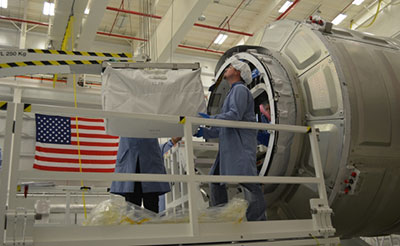 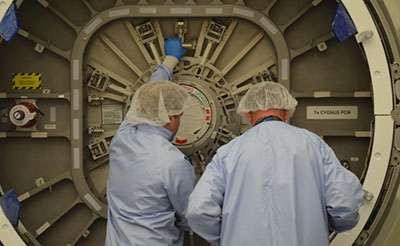
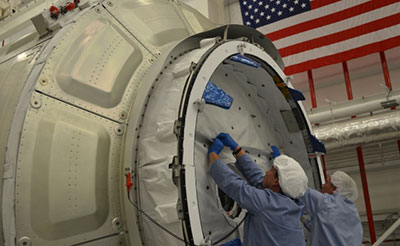
|
Robert Pearlman
Editor Posts: 42988
From: Houston, TX
Registered: Nov 1999
|
 posted 09-13-2013 12:39 AM
posted 09-13-2013 12:39 AM
   
Orbital Sciences photo release Fairing Encapsulation Complete, Roll Out is NextOrbital Sciences' Cygnus cargo spacecraft was encapsulated in the 32.48 foot (9.9 meter) long Antares fairing on Sept. 9, 2013 at the Horizontal Integration Facility (HIF) at Wallops Island Flight Facility. Technicians will perform final close outs in advance of roll out to Pad 0A, currently scheduled to occur early Friday morning. 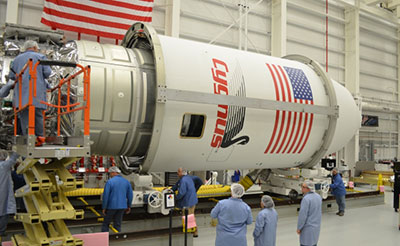 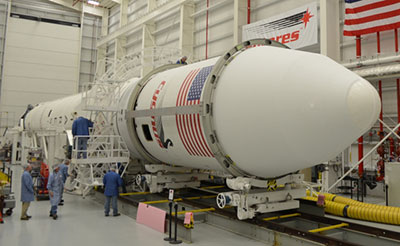
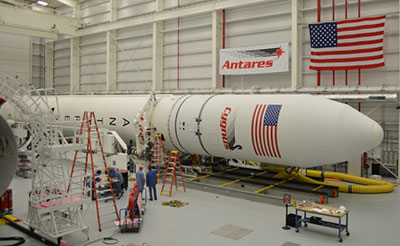
|
Robert Pearlman
Editor Posts: 42988
From: Houston, TX
Registered: Nov 1999
|
 posted 09-13-2013 05:54 PM
posted 09-13-2013 05:54 PM
   
Orbital Sciences release Orbital Rolls Out Antares Rocket To Wallops Launch Pad For Cots Demonstration Mission To International Space StationEarlier today, Orbital Sciences Corporation rolled out its Antares rocket that will launch the company's first Cygnus spacecraft to the International Space Station (ISS) for its demonstration mission under the Commercial Orbital Transportation Services joint development program with NASA. Orbital is currently targeting Tuesday, September 17 for the launch during a 15-minute window from 11:16 to 11:31 a.m. (EDT). During the mission, the Antares rocket will boost the Cygnus spacecraft into a parking orbit of about 245x300 kilometers in altitude, inclined at 51.6° to the equator. 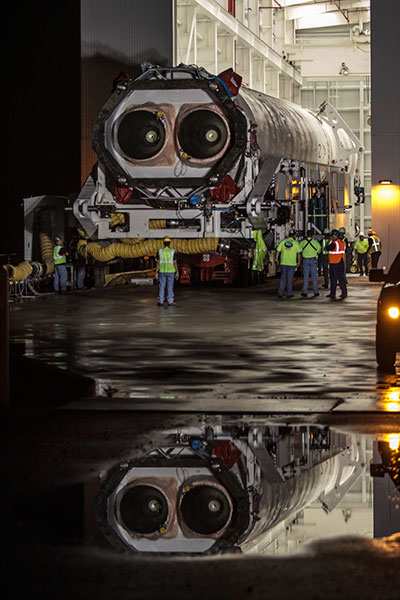 Roll-out operations began at about 2:30 a.m., with the Antares rocket first emerging from its Horizontal Integration Facility at about 3:45 a.m. this morning. The rocket was transported about one mile to the Mid-Atlantic Regional Spaceport (MARS) launch complex, known as Pad 0A, aboard the Transporter/Erector/Launcher (TEL), a specialized vehicle that also raised the rocket to a vertical position on the launch pad and serves as a support interface between the rocket and the launch complex's systems. By about 1:00 p.m., Antares was in a fully vertical position on the launch pad. Following its launch by the Antares rocket, Cygnus will conduct an extensive series of in-orbit maneuvers and demonstrations over a five-day period to verify that all onboard operating systems are functioning properly and that ground controllers at Orbital's Mission Control Center (MCC), located at the company's Dulles, VA campus, are able to command, control and communicate with the spacecraft as designed and extensively rehearsed. Assuming a September 17 launch, Orbital and NASA are currently targeting the morning of Sunday, September 22, for the Cygnus rendezvous, grapple and berthing operations with the ISS at an altitude of about 415 kilometers above the Earth. 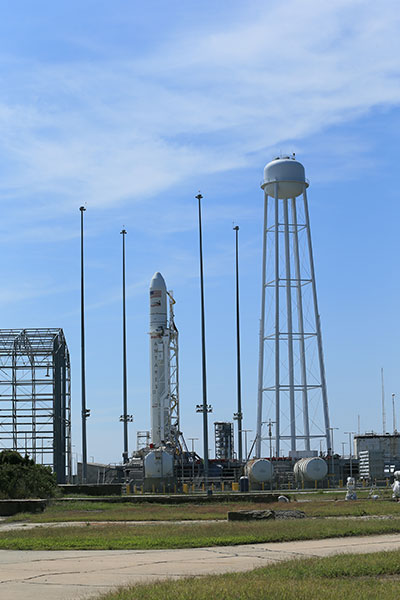 On its demonstration mission, Cygnus will deliver approximately 700 kilograms of cargo, including food and clothing, to the Expedition 37 crew, which will also load Cygnus with disposal cargo prior to its departure from the station approximately 30 days later. Mr. David W. Thompson, Orbital's Chairman and Chief Executive Officer, said, "Today's roll-out of the fully integrated Antares rocket and Cygnus spacecraft, along with this weekend's on-pad testing and readiness review, are the final steps leading up to next week's launch of our COTS demonstration mission. This mission will mark the completion of a five-year journey that NASA and our company embarked on in 2008 to create a new medium-class rocket, a sophisticated logistics spacecraft and a world-class launch site at the Wallops Flight Facility." Following a successful COTS demonstration mission, Orbital plans to begin regularly scheduled cargo supply missions under its Commercial Resupply Services (CRS) contract with NASA later this year. Orbital is currently scheduled to launch the first of eight CRS missions to the ISS as early as December. All CRS flights will originate from NASA's Wallops base, which is geographically well suited for ISS missions and can also accommodate launches of scientific, defense and commercial satellites to other orbits. |
Robert Pearlman
Editor Posts: 42988
From: Houston, TX
Registered: Nov 1999
|
 posted 09-14-2013 12:16 PM
posted 09-14-2013 12:16 PM
   
Orbital Sciences release Antares launch delayed until Sept. 18Following a launch review meeting held earlier this morning (Sept. 14), Orbital's Antares team has decided to postpone the launch of the COTS Demonstration mission from Wallops Island, Virginia by at least 24 hours. The combination of yesterday's (Sept. 13) poor weather that delayed roll-out of the rocket to the launch pad and a technical issue that was identified during a combined systems test held last night involving communications between ground equipment and the rocket's flight computer drove the decision to delay the launch. After comprehensive inspection and testing this morning, the problem was found and turned out to be an inoperative cable, which is being replaced. Orbital will repeat the combined systems test later today. Once that important test is successfully completed, the team will be able to proceed toward a Sept. 18 launch. The launch window on Sept. 18 is from 10:50 to 11:05 a.m. (EDT). |
Robert Pearlman
Editor Posts: 42988
From: Houston, TX
Registered: Nov 1999
|
 posted 09-18-2013 10:15 AM
posted 09-18-2013 10:15 AM
   
collectSPACE Cygnus takes flight: Orbital Sciences' new spaceship lifts off for stationA thunderous roar rolled over the Virginia seaboard on Wednesday (Sept. 18) as the first of a new type of commercial cargo spacecraft set off on its maiden flight to the International Space Station (ISS). The unmanned space freighter is now on a month-long mission to demonstrate to NASA it can be used to deliver supplies to the orbiting outpost. Orbital Sciences Corp. launched its first Cygnus resupply spaceship on the company's second Antares rocket to fly. The 10:58 a.m. EDT (1458 GMT) liftoff was the first time a U.S. space station-bound mission began from somewhere other than Florida's space coast.
|
Robert Pearlman
Editor Posts: 42988
From: Houston, TX
Registered: Nov 1999
|
 posted 09-19-2013 12:18 PM
posted 09-19-2013 12:18 PM
   
Orbital Sciences update Cygnus Demos 2a and 2b completedSince launch yesterday at 10:58 a.m. Eastern Daylight Time (EDT), Orbital's Cygnus logistics spacecraft and its team have been busy and performing well. After successfully completing two orbit-raising Delta V (DV) burns, the team carried out free drift and abort demos (known as Demos 2a and 2b). This marked the first of 10 demonstration milestones for Cygnus on its way to the International Space Station. The team is packaging data from the test for NASA's review and approval, which is expected to be received today. The next DV burn, DV3, is planned for approximately 3 p.m. EDT today, Thursday, Sept. 19. |
Robert Pearlman
Editor Posts: 42988
From: Houston, TX
Registered: Nov 1999
|
 posted 09-21-2013 01:27 PM
posted 09-21-2013 01:27 PM
   
Orbital Sciences update Cygnus COTS Demonstration StatusBefore Cygnus can rendezvous and berth with the International Space Station (ISS), it must perform several thruster firings to raise its orbit and catch up with the ISS. Cygnus must also perform 10 maneuvers to demonstrate the safety capabilities of the Cygnus. Once each demonstration maneuver is complete, Orbital will send a data package to NASA for review to verify that the demonstration has met its objectives. Since the launch of the spacecraft at 10:58 a.m. on Wednesday, September 18, the Cygnus team has been busy completing the first two of 10 required in-orbit demonstrations and has successfully conducted four Delta V burns to raise Cygnus' orbit. On Friday (Sept. 20), the team conducted Delta V burn no. 4 to raise Cygnus' orbit to within 4 km of the ISS orbit altitude. If needed, an additional burn may be conducted in Saturday, September 21, to "fine tune" Cygnus' orbit. The Cygnus team is busiest on Sunday, September 22, the day of rendezvous, grapple and berthing with the ISS. That day, the remaining eight demonstrations and a series of smaller Approach Delta Velocity (ADV) burns will be carried out prior to capture by the station crew and berthing with the ISS. Once the final demonstration maneuver is deemed successful, NASA will give approval for the approach to within 10 meters of the station where Cygnus will be grappled by the robotic arm and guided to its berthing port. | Completed | Free drift and abort demonstration | Demonstrate the spacecraft's ability to float freely with all of its thrusters inhibited and to safely move away from the station if necessary | | 9/22 | Position and attitude control demonstration | Test the spacecraft's ability to hold its position | | 9/22 | Relative GPS navigation demonstration | Verify the spacecraft's GPS-based navigation system is operating as expected | | 9/22 | Onboard targeting demonstration | Confirm the spacecraft's ability to maneuver to a targeted position in space | | | ADV 1 | Raises Cygnus from 4 km below ISS to 1.4 km | | 9/22 | Reaction Engine Assembly (REA) maneuver demonstration | Demonstrate Cygnus' attitude control system's ability to maneuver | | | ADV 2 | Moves Cygnus closer to R-Bar (directly below the ISS) | | 9/22 | Hardware Command Panel (HCP) checkout | Verify that the ISS crew can command Cygnus using the HCP aboard the Station | | | ADV 3 | Positions Cygnus to intersect the R-Bar | | 9/22 | LIDAR navigation demonstration | Confirm that Cygnus' laser navigation sensor's position and velocity data is accurate and as expected in prefight simulations | | | ADV 4 | Continues Cygnus' ascent on the R-Bar toward 250m | | 9/22 | ADV 5 | Continues Cygnus ascent up the R-bar | | 9/22 | Retreat demonstration | Verify that the ISS crew can command Cygnus to retreat away from the ISS, if needed | | 9/22 | Hold demonstration | Verify that the ISS crew can command Cygnus to hold during approach, if needed | | 9/22 | LIDAR single reflector tracking demonstration | Demonstrates Cygnus' LIDAR's capability to focus on a single reflector on the ISS |
|
Robert Pearlman
Editor Posts: 42988
From: Houston, TX
Registered: Nov 1999
|
 posted 09-22-2013 03:35 AM
posted 09-22-2013 03:35 AM
   
Orbital Sciences update Data issue delays space station rendezvousSunday morning (Sept. 22), at around 1:30 a.m. EDT (0530 GMT), Cygnus established direct data contact with the International Space Station and found that some of the data received had values that it did not expect, causing Cygnus to reject the data. This mandated an interruption of the approach sequence. Orbital has subsequently found the causes of this discrepancy and is developing a software fix. The minimum turnaround time to resume the approach to the ISS following an interruption such as this is approximately 48 hours due to the orbital mechanics of the approach trajectory. |
Robert Pearlman
Editor Posts: 42988
From: Houston, TX
Registered: Nov 1999
|
 posted 09-22-2013 09:26 AM
posted 09-22-2013 09:26 AM
   
Orbital Sciences update Next rendezvous attempt early Tuesday morningFollowing the discovery of a data format discrepancy between an on-board International Space Station (ISS) navigation system and a similar system on Cygnus at around 1:30 a.m. EDT (0530 GMT) Sunday morning (Sept. 22), today's rendezvous with the station was postponed. At this time, NASA and Orbital are developing a detailed plan for a second rendezvous attempt early Tuesday morning. A software update has been developed and will be tested on a ground-based simulator during the day on Sunday. Upload to Cygnus and in-orbit testing of the software "patch" is planned for Sunday night and into Monday morning. Once this has been accomplished and verified, the current plan is for Cygnus to begin a second rendezvous approach late Monday night, with final approach to the ISS and grapple taking place early Tuesday morning. The Cygnus spacecraft remains healthy, with all major subsystems operating as expected. |
Robert Pearlman
Editor Posts: 42988
From: Houston, TX
Registered: Nov 1999
|
 posted 09-23-2013 09:33 AM
posted 09-23-2013 09:33 AM
   
Orbital Sciences update Cygnus berthing to wait for Soyuz dockingMonday morning (Sept. 23), Orbital and NASA together decided to postpone the approach, rendezvous, grapple and berthing operations of the Cygnus cargo logistics spacecraft with the International Space Station until after the upcoming Soyuz crew operations are complete. The Soyuz crew is due to arrive at the ISS very late on Wednesday (Sept. 25). The earliest possible date for the next Cygnus approach and rendezvous with the ISS would be Saturday (Sept. 28). An exact schedule will be determined following the successful completion of Soyuz operations. Over the past 24 hours, the Orbital Sciences team developed and tested a software fix for the data format mismatch that necessitated a postponement of the first rendezvous operation that was scheduled for the early morning of Sept. 22. However, that process, together with the impending Soyuz operations, resulted in a tight schedule to the point that both Orbital and NASA felt it was the right decision to postpone the Cygnus approach and rendezvous until after Soyuz operations. "This new schedule will allow the Orbital operations team to carefully plan and be well-rested before restarting the critical final approach to the space station. Meanwhile, Cygnus has all the resources needed to remain in orbit for an extended period of time," said Mr. Frank Culbertson, Orbital's Executive Vice President and General Manager of its Advanced Programs Group. |
Robert Pearlman
Editor Posts: 42988
From: Houston, TX
Registered: Nov 1999
|
 posted 09-26-2013 09:31 PM
posted 09-26-2013 09:31 PM
   
Orbital Sciences update Orbital targeting a Sunday berthing for CygnusThe Cygnus remains healthy in-orbit, with all major onboard systems performing as expected. Over the past several days, the Cygnus engineering team developed, validated and uploaded the one-line software "patch" that resolved the GPS data roll-over discrepancy that was identified during the initial approach to the International Space Station last Saturday (Sept. 21). Orbital and NASA are currently discussing the best rendezvous opportunity, with the current trajectory plan supporting Sunday morning (Sept. 29), as the next opportunity to rendezvous with and approach the ISS. This schedule is still subject to final review and approval by the NASA and Orbital teams. The Cygnus spacecraft is currently holding at about 1,500 miles (2,400 kilometers) behind the ISS. Later Thursday evening (Sept. 26), Cygnus will perform the first of a series of thruster burns to begin the journey back towards the ISS to be in the right position for a rendezvous as early as Sunday morning. Since its launch from Wallops Island, VA on September 18 aboard our Antares rocket, the Cygnus mission operations team has been monitoring the spacecraft 24/7 with two operational teams — the blue team and the green team — pulling alternate shifts. Program personnel are well-rested and fully prepared for Sunday's approach and rendezvous. |
Robert Pearlman
Editor Posts: 42988
From: Houston, TX
Registered: Nov 1999
|
 posted 09-29-2013 06:18 AM
posted 09-29-2013 06:18 AM
   
collectSPACE Commercial Cygnus spacecraft makes first arrival at space stationA private cargo spacecraft made a delayed but successful arrival at the International Space Station (ISS) on Sunday (Sep. 29), becoming the first of a new type of commercial spaceship to rendezvous with the orbiting laboratory. Orbital Sciences' inaugural Cygnus unmanned spacecraft approached the station from below, autonomously flying to within 40 feet (12 meters) of the sprawling complex before being grappled by the station's robot arm at 6:00 a.m. CDT (1100 GMT). "Cygnus capture complete," said European Space Agency astronaut Luca Parmitano, who was at the controls of the station's robotic arm when the Cygnus was captured. 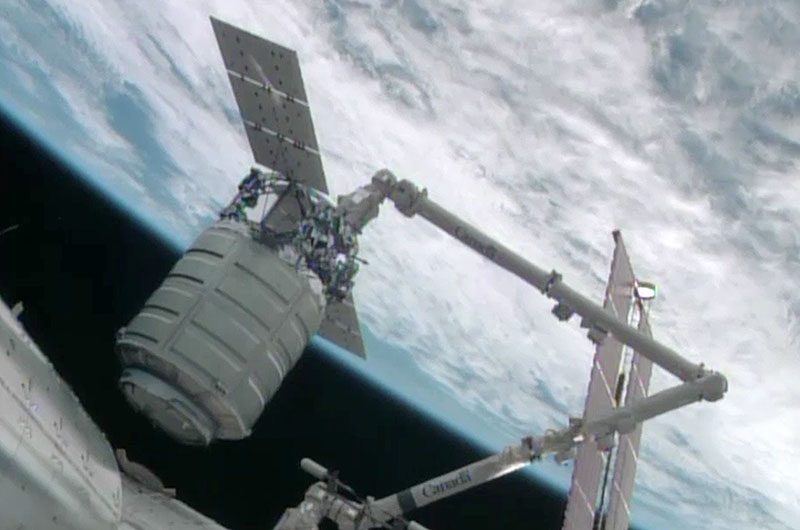 |
Robert Pearlman
Editor Posts: 42988
From: Houston, TX
Registered: Nov 1999
|
 posted 10-22-2013 06:46 AM
posted 10-22-2013 06:46 AM
   
collectSPACE 1st Orbital Cygnus freighter departs space station, heads for destructive re-entryThe Spaceship G. David Low – named in memory of Low, who made three spaceflights and helped lead the Virginia-based Orbital's development of a commercial cargo launch service prior to his death in 2008 — was released from the space station at 6:31 a.m. CDT (1131 GMT) on Tuesday (Oct. 22). On Wednesday, the Cygnus, orbiting free from the station and under the control of Orbital's flight engineers, will fire its engines for a last time at 12:41 p.m. CDT (1741 GMT), setting up its fiery re-entry over the Pacific Ocean. 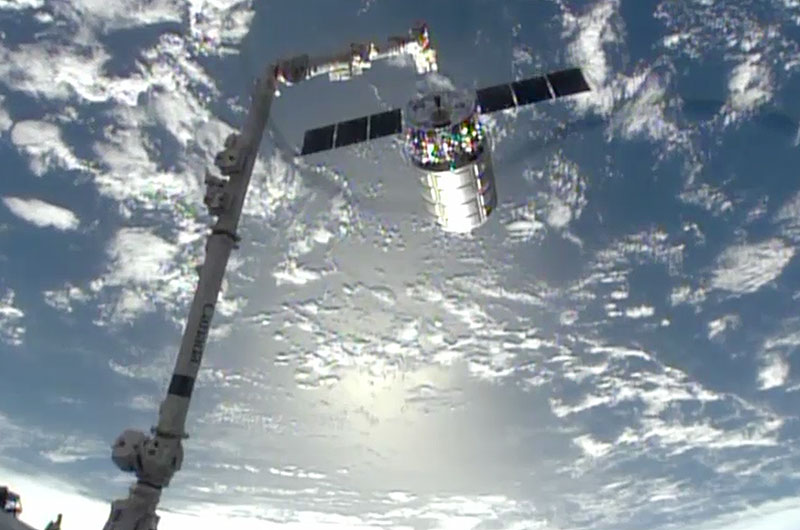 |
Robert Pearlman
Editor Posts: 42988
From: Houston, TX
Registered: Nov 1999
|
 posted 10-23-2013 04:16 PM
posted 10-23-2013 04:16 PM
   
Orbital Sciences release Orbital Completes COTS Demonstration Mission to International Space StationOrbital Sciences Corporation, one of the world's leading space technology companies, today (Oct. 23) confirmed that its Cygnus cargo logistics spacecraft reentered Earth's atmosphere over the Pacific Ocean east of New Zealand at approximately 2:15 p.m. (EDT). Cygnus unberthed from the International Space Station (ISS) yesterday following its 23-day stay at the station. The successful conclusion to its demonstration mission also completes the Commercial Orbital Transportation Services (COTS) joint research and development initiative with NASA. Orbital is now ready to begin regularly scheduled resupply flights to the station later this year as part of a $1.9 billion Cargo Resupply Services (CRS) contract with NASA. Upon the successful unberthing and departure from the ISS yesterday, NASA Administrator Charles Bolden said, "Congratulations to the teams at Orbital and NASA who worked hard to make this demonstration mission to the International Space Station an overwhelming success. Orbital's success today is helping make NASA's future exploration to farther destinations possible." For the COTS demonstration mission, Orbital launched its Antares rocket carrying its Cygnus cargo logistics spacecraft on September 18 from the Mid-Atlantic Regional Spaceport (MARS), located at NASA's Wallops Flight Facility in eastern Virginia. Following its launch and in-orbit testing and demonstration maneuvers, Cygnus rendezvoused and berthed with the ISS on September 29. Prior to its departure from the station yesterday, the astronauts loaded the cargo module with nearly 3,000 lbs. of unneeded items for disposal. "With the COTS development phase now successfully completed, we are now turning our full attention to the eight operational resupply missions covered by our Commercial Resupply Services contract with NASA," said Frank Culbertson, Orbital's Executive Vice President and General Manager of its Advanced Programs Group. "Each Cygnus is capable of delivering a large quantity of pressurized cargo, totaling up to 20,000 kg over the eight missions, including crew supplies, spare parts and equipment, and scientific experiments for the ISS. We are looking forward to starting these missions in December." Over the past five years, Orbital privately developed the Antares launch vehicle to provide low-cost, reliable access to space for medium-class payloads, while also developing the Cygnus spacecraft in conjunction with NASA under the COTS program to meet the stringent safety requirements for ISS operations. Together these products showcased Orbital's ability to apply commercial business practices and engineering approaches to significantly shorten development timelines and lower operational costs of sophisticated space systems as compared to traditional government-run programs. See here for discussion of Orbital's Antares-Cygus COTS demo flight. | |
Contact Us | The Source for Space History & Artifacts
Copyright 2020 collectSPACE.com All rights reserved.

Ultimate Bulletin Board 5.47a
|
|

|
 advertisement advertisement

|























